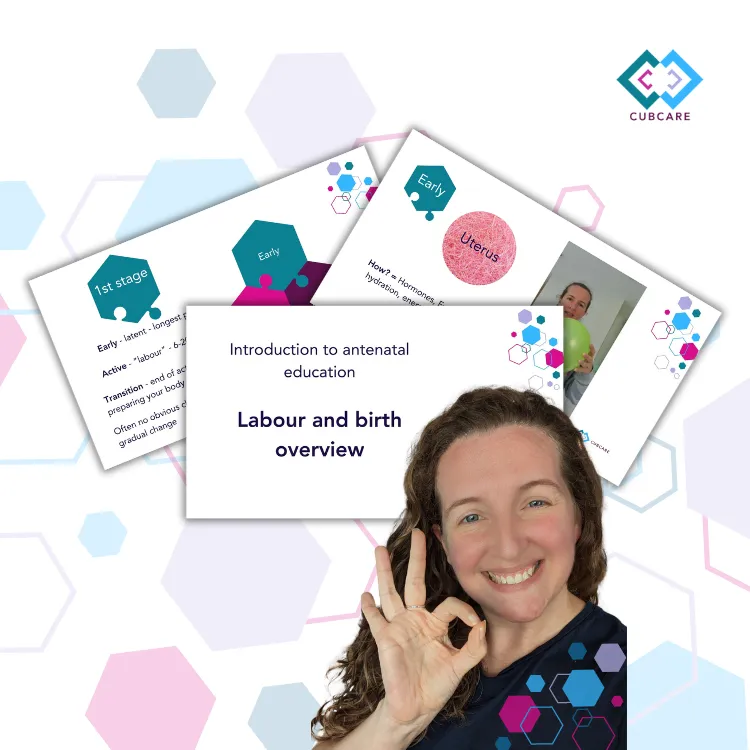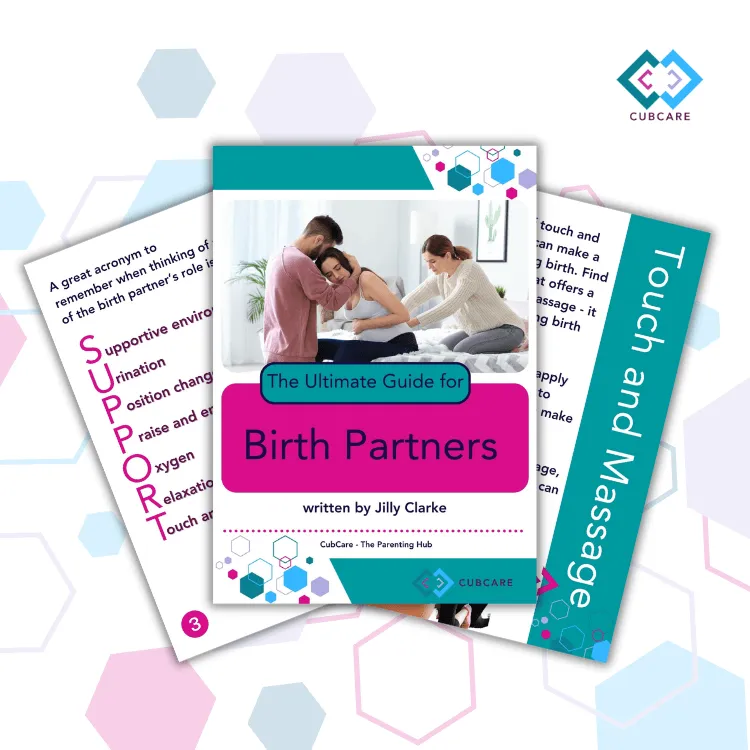We're an award winning Antenatal and Postnatal Education Platform 2025!
(read more here)
CubCare blogs.
From early pregnancy to newborn development.
Advice to help through pregnancy, birth and childhood.
BLOG

Gas and Air labour pain relief
“Gas and air, like a lot of the medical pain relief methods offered in labour aren't actually pain relief. Gas and air, for instance is designed to help you relax and care less about the sensations!” - Jilly
Let's talk about pain relief in labour - Gas and Air
There are multiple medical forms of pain relief that might be offered to you during your birth. But there are also a multitude of self-help comfort measures that can make a huge difference too. Even if you are choosing to use all the different forms of medical pain relief, there will be some time between you choosing to need something and it being administered and making a difference.
The main forms of medical pain relief are gas and air or entonox, pethidine or diamorphine (injected opioid based drugs) or epidural. We know that having techniques to use when you feel like you need them is so helpful. Some medical forms of pain relief can take 20 minutes to take effect, so understanding medical pain relief and having some breathing and relaxation techniques can bridge that gap from when you decide that you need something extra to the time it is helping your body.
The best alternatives for medical pain relief in labour can be found in this blog.
Having a variety of tools to help bridge this time gap is so helpful, and can help you feel in control.
In our Antenatal Courses and our Refresher Antenatal Course, we spend quite a bit of time talking about pain relief in labour. Most importantly, we make sure you are comfortable with using a variety of techniques alongside different forms of pain relief. Some options have risks, or can impact your birth but we talk about ways of minimising less than ideal outcomes
In this blog we’ll talk about the first step on the medical pain relief ladder, Gas and Air. We’ll also talk about how it can work really well with my favourite self-help comfort measure, breathing.

Gas and air, what is it? How does it work?
Gas and Air, or Entonox is a popular choice for pain relief in labour with 50-70% of people potentially using it during labour. It is generally plumbed into the wall giving the labouring person an unlimited supply. In a home birth setting it is provided in large cylinders which can be replaced and refilled as required.
The gas and air is attached to a large pipe, enabling movement during labour and change position with ease. There is a mouthpiece that is put between your lips and the air taken into your body through inhalation (breathing) through the mouth.
Gas and air can be used individually, or in conjunction with other pain relieving options. Pain relief such as breathing and relaxation techniques, a birthing pool, TENS, pethidine and even with an epidural for any breakthrough discomfort.
The gas is inhaled through a mouthpiece throughout the duration of a contraction. The aim is it reaching peak effectiveness at the peak of the contraction. It takes about 20 seconds to influence your body, taking the edge off contractions. Because it doesn't stay in your system very long, it is thought to not cross the placenta into baby, nor have an affect on them.
Side effects of gas and air
Side effects for the birthing person may include – feeling dizzy, nauseous, a change in the sound of your voice, hysteria (laughing), dry mouth and tingly fingers.
A study published in 2024 focusing on males, because there is a higher incidence of nausea in females...they found that after 20 minutes of continuous breathing of the gas, "experiences under nitrous oxide sedation are extremely variable and not always pleasant." They identified two themes: nitrous oxide is mind-altering and produces sensory overload.
It is useful to note that these side effects pass as soon as you stop using the gas and air and breathe fresh air. You will be encouraged to do this in between contractions so plenty of time for fresh air.
It is easy to put the mouthpiece to one side and try something else if you dislike it.
The mind-altering properties were represented by dreamlike states and heightened emotions. Heightened emotions included euphoria, anxiety, and fear of losing control. Sensory overload consists of distorted perception, bodily sensations, and a heightened sense of surroundings. - More than just joy: A qualitative analysis of participant experiences during nitrous oxide sedation - Valtonen - 2024 - Acta Anaesthesiologica Scandinavica - Wiley Online Library
7 top tips for using Gas and Air
1. Breathe in as soon as you start to feel the sensation of a contraction begin. This means that by the time it kicks in (after 20 seconds), you will get the benefit of pain relief at the peak of your contraction.
2. Breathing should be slow, deep and steady – our Glide breath is perfect for this but a slow version of the Climb breath can be effective too. Timing is essential to enable the gas and air to be effective. Starting controlled breathing at the start of the contraction, easing off once you've hit the peak and you can feel it easing off again. Or your midwife may talk you through the first couple of contractions until you are confident in using it properly.
3. When you feel that you’ve hit the peak of the contraction and you are starting to relax down the other side, stop using the gas and air. Instead concentrate on relaxing your muscles and focus on long, slow glide breathing. This allows the gas and air to leave your system.
4. Try and keep your jaw, shoulders, arms and hand as relaxed as possible. Tension through your upper body can cause your whole body to tense. This can use adrenaline, and tension in the rest of your body – making contractions seem more difficult!
5. Get a birth partner to keep reminding you to relax your body, or better still, to hold the gas and air for you!
6. Don’t use it in between contractions otherwise you might find yourself too relaxed – stick with using it for the contractions only.⠀
⠀
7. Keep a bottle of water with a straw nearby as you may find your mouth can get very dry. And use your lip balm!
You can use it in pretty much most birthing situations so know that it’s there for you to use. If you don't like how it makes you feel, it is easy to stop using it.

Gas and air, what if it is not available?
In 2023 there was news that many hospital settings has suspended the use of Gas and Air due to potential risks to staff from continued exposure. Many settings have assessed their provision and either updated or took the decision to suspend use of plumbed in gas and air.
There was never a risk for birthing people, birth partners of babies, it was a risk concern for the staff and prolonged exposure.
Most settings who suspended the use of gas and air have reinstated it, or providing alternative options now.
If you are concerned then speak with your midwife, and consider the best alternatives for medical pain relief in labour can be found in this blog.
You always have choices, you always have options.
But our bodies are SO capable. With the trust, the knowledge and the education you CAN have an amazing birth experience.
That's why we have our Antenatal Course (both in person and online), Refresher Antenatal Course (both in person and online), and our Birth Partner course so that everybody can get knowledgeable and confident for birth.
Refresher Antenatal Course in person
Refresher Antenatal Course online
Birth Partner course (included in our Antenatal course)
Antenatal Course in person
Antenatal Course online
Easily navigate to our most popular Blog categories
Download our Freebies

Labour and Birth
Watch our introduction to antenatal education webinar, our labour and birth overview - to start your antenatal education journey. Understanding the process, and what you can do to influence it.

Pregnancy Planner
Free Pregnancy Planner to help you prepare for a little one. Prepare your body, your mind, your finances and your home. Get organised, feel good and prepare for an active, positive birth.

Birth Partner Guide
Your ultimate guide to being the best birth partner during pregnancy, birth and recovery. Learn what you need to do, and what you need to learn to be the best birth partner possible.

Expecting Again Guide
Your ultimate guide to preparing for another birth and an extra baby. Our top tips for navigating pregnancy and birth, and helping your older ones to transition into their new role as a big sibling.
Based in Welwyn Hatfield, offering local pregnancy support and doula services across Hertfordshire: St Albans, Hatfield, Welwyn Garden City, Potters Bar, Stevenage, Harpenden, Hitchin, Barnet, Mill Hill and surrounding areas.
Online antenatal and postnatal education available UK-wide.
© Copyright 2025 CubCare The Parenting Hub. CubCare is operated by The Birth and Baby Company Ltd. Company No. 15655287
Privacy Policy | Terms & Conditions | Medical Disclaimer | Inclusivity and Accessibility

